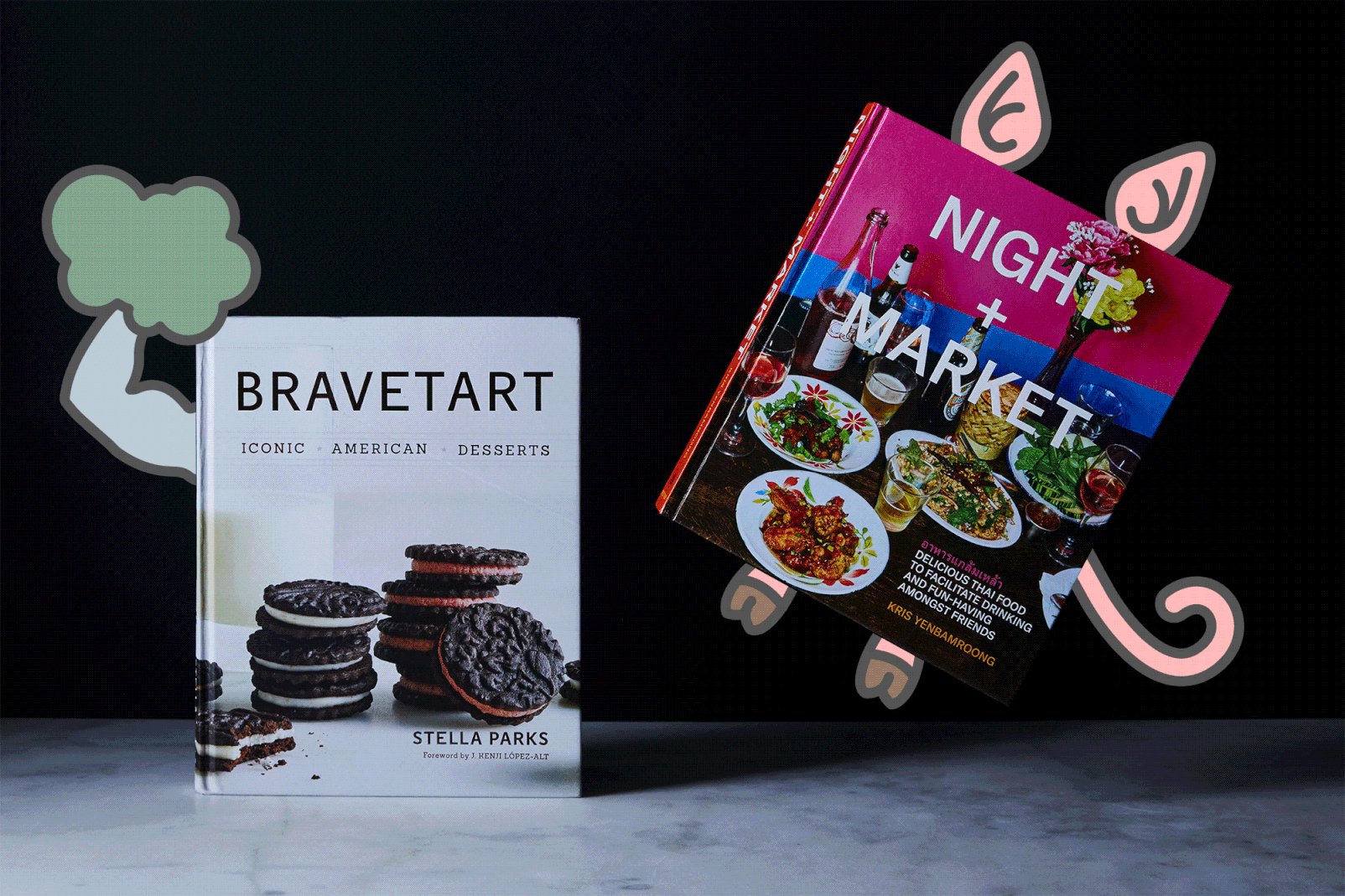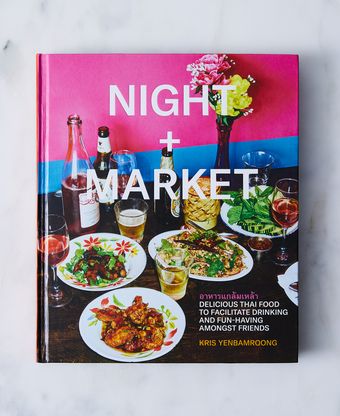Comparing apples to oranges is not something I anticipated when I accepted the challenge to judge two extraordinary cookbooks for The Piglet. I say “apples to oranges” because one book involves cooking and the other, baking. The way I see it, cooking is an art, and baking is a science. (Of course, there are almost too many exceptions to make this a rule, but it’s my review, so it’s my rule!)
As a creative director and an artist, I often feel more at home cooking than baking. Baking requires precision: measurement, speeds, temperatures, techniques. Cooking also has measurements, but they’re often more like suggestions, which suits me because I like to improvise and substitute. The spoon and knife are extensions of my hand the way a paintbrush is, and the ingredients are my palette.
I paint what I love and use in real life; it’s autobiographical. In fact, the edited subject matter of my work is as important as how I paint it. Below, I have painted what each book’s recipes inspired in me visually. Certain ingredients and tools leapt off the page and onto my paper; I really enjoyed digesting the recipes this way.
I lean towards recipes I find most beautiful in their simplicity, just as I paint things that inspire me in their functionality, guided by the principles “less is more” and “less, but better.”
In addition, I judge recipes on their return on investment: Are the results worth the effort and hours? It’s a venture to take your time making a recipe that, for some, could (more) easily be enjoyed out. That said, I taught myself how to cook by reading cookbooks. Some of my favorites are inspired by restaurants (e.g. The Frog Commissary Cookbook; The Union Square Café Cookbook). They’ve allowed me to recreate iconic dishes at home and learn new techniques along the way.
In deciding which recipes to test for The Piglet, I tried to cover a range of difficulty from each book, to keep things more or less even: a simple, classic dish, a slightly more finessed one, and then—because it’s occasionally fun to put in the extra effort—a labor-intensive showstopper.
In the end, I fell hard for both of these cookbooks. I initially thought the winner would be an easy pick. Instead, the more I read and cooked through each book, the more difficult it became to choose.

I cook every night and spend at least an hour in my kitchen: chopping, cutting, sizzling, dressing salads. I occasionally bake for fun, too. When I do, I opt for classic desserts: Charlotte Russe or Charlotte Chantilly (for my daughter, Charlotte’s, birthday every August!), Rice Krispies treats, banana bread when our bananas have gone brown.
My holy grail for dessert—something that transforms just a few simple ingredients into an utterly dazzling crowd-pleaser—is epitomized by Julia Childs’ Crème Caramel from Mastering the Art of French Cooking. I’ve made her recipe more than 30 times: in a studio apartment closet-kitchen; for a friend who lived a 40-minute ride away on Metro North; for Christmas dinner, hand-delivered from NYC to Massachusetts. (To manage this, I visited my local pizza joint to ask politely for 3 pizza boxes, and loaded the pans into them. The dish withstood the 4-hour car ride and unmolded beautifully onto a crystal platter.) Crème Caramel is pretty much all we need—well, besides really good ice cream, strawberry shortcake, carrot cake, cream cheese icing, homemade whipped cream, angel food cake, and Thin Mints.
So you can imagine my excitement when BraveTart appeared on my doorstep, full of classic dessert recipes. This is it, I thought. It’s like author Stella Parks has cataloged all those childhood desserts stashed in the “nostalgia” section of my brain, mastered the recipes for every single one, and given them to me here: Nutter Butters, Pop Tarts, Classic Yellow Layer Cake, and, best of all, Thin Mints. It’s like she time-traveled to Duncan Hines’ house, stopped at Keebler Village, and dashed through the Hostess and Tastykake HQs.
My idea was to make one recipe every other day. I planned to share some portions with friends, or give them away. Because my access to special tools and equipment was up in the air, due to a busy travel schedule, I chose recipes that I thought would be amenable to some elbow grease.
I started with Chopped Chocolate Chip Cookies. Like City Bakery’s, these were mini salty-chocolate dreams. They tasted more sophisticated than any cookie I’d ever made, and were easier—and faster—than the recipe on the back of a bag of chocolate chips. No crazy ingredient-hunting or prep; chopping chocolate bars and mixing by hand was a breeze. I substituted Sucanat for white sugar, since I prefer to use unrefined ingredients when possible. No stand mixer? No problem. These mixed up easily by hand.
Next, Homemade Rice Krispies Treats, as in “make your own marshmallow creme, plus use a thermometer and gelatin” Rice Krispies treats. These failed epically for a few reasons. First, I realized that my thermometer was a meat thermometer (whoops!), which meant it couldn’t properly register the temperature needed. Again, I replaced white sugar with Sucanat, which doesn’t work so well when heated into marshmallow creme (uh oh!). Last, no amount of elbow grease could’ve helped me whip and scrape and fold the way I needed to in this recipe—made by hand, rather than with a stand mixer as suggested, the result was an oozy (but tasty) mess. My verdict? I prefer “what’s wrong with the recipe on the back of the cereal box?” Rice Krispies treats. I would try Parks’ recipe again with the proper ingredients and tools, but...it felt more complicated than I’d bargained for.
Parks’ Red (Wine) Velvet Cake, on the other hand, was my pièce de résistance—simply, the best cake I’ve ever made. It was bakery-level, as if I’d bought it somewhere fancy and not made it myself. What I loved most was that it wasn’t too sugary, and had just the right touches of bitterness from the chocolate and jammy sweetness from the namesake wine. No flavor was too predominant, which, in my book, means balance and perfection. Plus, the recipe taught me all about the cake’s provenance (the Waldorf Astoria bake-off). Its burgundy color comes not from food coloring, but the wine and some raw cacao powder, which I thought was a clever touch.
The Cream Cheese Frosting (which involved steeping milk, cooking a custard, and letting it set before finishing the buttercream) was ultra light, but almost not “homemade” enough—it was very elegant and, for my taste, lacking in tangy cream-cheesiness. So I added more lemon juice and all was well. We ate the frosted cake for dinner, breakfast, and lunch for two days, and never got tired of it.
Next time I cook from BraveTart, I will be sure to use a stand mixer for every recipe that suggests it. My arms are just not strong enough to beat the way this book’s recipes need be aerated; minutes of whipping turned into what felt like hours for my biceps and shoulders. However, the “Iconic Desserts” (per the book’s subtitle) were well worth the effort, and I plan to try more of them—they’re classics I can return to time and again.

Night + Market had me at its colorful cover: fuchsia and cerulean blue with a white sans serif typeface, and “+” instead of the word “and” or an ampersand—a typographical tendency I also lean towards. The cover’s electric colors are a signifier for both the bright flavors inside the book, and for author Kris Yenbamroong’s unique, L.A.-influenced vibe. I couldn’t wait to try my hand at these Thai classics with a modern backdrop.
That said, I also thought, “This is going to be hard.” I’ve tried making Thai food at home before; for me, it never quite turns out like at a restaurant. But ultimately, I like good art direction, so I was enticed to start flipping through Night + Market anyway. Every recipe is illustrated with a photo of a perfectly plated dish. The book (and the restaurant it’s named for) oozes hipster haute cuisine.
I thought it’d be fun to plan one big Thai feast to enjoy multiple recipes, family style, with dozens of small bowls of condiments, toppings, sauces and accoutrements for sharing. We had 7 people around the table, ranging in age from 4 to 48. This was an experiment that everyone opted in on.
Once I’d invited my brother, sister-in-law, and two nieces to join us for dinner, sourced all the ingredients, sent my husband to buy beers (a high-low mishmash of everything from Amarillo IPA to Budweiser), and got out my most colorful serving dishes, tablecloth, and enamel plates (to copy the prop styling in the pics!), I was cooking with gas. Literally: I blasted the flame as high as I could under a small wok, which I borrowed from my sister-in-law. I also used a regular old cast iron pan and a sturdy enamel skillet as wok stand-ins. They did the job.
The ingredients were remarkably fresh and fragrant, and most of them were easy to find in my neighborhood store’s produce aisle. However, the ingredient list also involved some sub-recipes, including one for Roasted Chile Powder, so I was on the hunt for dried Thai bird’s eye, pulla, or árbol chiles. I wasn’t able to find those varieties, but I did come across a chile jam very similar to a recipe in the book. Though the Roasted Chile Powder is a “nonnegotiable,” per Yenbamroong, we ended up using the chile jam as a substitute because we were in a pinch—both my brother and husband loved it.
I tried the Chicken Larb. This spicy minced meat salad, brimming with fresh hand-torn greens, is my new favorite go-to recipe. You get this awesome amalgamation of flavors, introduced to the dish in a particular order: seasoned ground meat, chile powder, red and green onion, mint, cilantro, and lime juice. To this, you add colorful vegetables, like crunchy cabbage leaves, green beans, and cucumbers sliced on an angle. It’s also meant to be served with sticky rice. I sprang for a package that read “Jasmine Rice Made in Thailand,” and cooked it on the stovetop in a copper pot (that I lugged back from Paris in my suitcase a decade ago). I followed the directions Yenbamroong gives in the book, rather than the ones printed on the bag of rice. Worked perfectly.
Next up, the Stir Fried Greens with Mushrooms and Tofu, which were silky-smooth and perfumed with a bold but harmonious mix of sesame oil, garlic, sugar, soy sauce, and ginger. Stir-frying the ginormous chard and torn oyster mushrooms in the wok made me feel like I was a pro, even though my mini wok was more like a crepe pan compared to the enormous ones I saw in the book, with clouds of steam erupting above the chef.
This was followed by the Pad Thai with Shrimp, which was my nieces’ favorite. Yenbamroong’s prep notes for this dish are foolproof: He suggests using dried rice stick noodles over fresh, and calls for soaking them in warm water instead of boiling them, then draining. His instructions to toss in all of the toppings together with the noodles to taste, instead of keeping them separate, especially resonated with me, as my favorite thing to make is a big, hearty, improvised salad; the pad thai, with its pops of flavor and seemingly infinite combinations, fit the bill.
The next day, we had a little bit of leftovers from each dish. For lunch, I fired up the wok with some sesame oil, and combined the remaining ingredients from all three recipes, including white rice, crunchy raw vegetables, mint, peanuts, lime—everything I’d bought to make said recipes. Delicious, round 2!
Looking through the book a few days later, I flagged one recipe to return to: Kung Pao Eggplant Tacos. (What? You’re taking Thai food on a parade through Mexico, Kris Yenbamroong? Yes, please.) After seeing it, I got on Instagram, found @ntmrkt, and fell down the rabbit hole. Like the book itself, @ntmrkt gave me such an incredible sense of the author’s restaurant: You might not be able to tell much from the outside, but you step inside to find it’s filled with big groups of friends, all smiling and sweating from the spiciness while they devour Mexican-Thai food on colorful enamel plates, under a 90s framed poster of Cindy Crawford in cut-off jean shorts.
Verdict:
Both books are packed with invaluable lessons and inspiring photos. From Yenbamroong’s recipes, as well as Parks’, I learned that the order in which you add ingredients (not to mention pairs and trios of ingredients) and layer flavors makes a huge impact on the final result.
In BraveTart, I see the painstaking accuracy and pure enjoyment that go into creating these treats. With Parks’ recipes, you can make at home the classics you thought you could only get from bakery cases or supermarket shelves. Despite my preference for the art of cooking over the science of baking, I can’t deny that Parks does a fantastic job of demystifying the crumb structure of cake, the process behind marshmallow making, and the texture of a perfectly creamy custard.
From Night + Market, I learned I can be as at home improvising with a wok as I am painting in my studio. The book is direct, but the experience of reading it is deep. Plus, Yenbamroong has the personality of someone I want to hang out with (and he runs a restaurant I want to hang out in).
It is with a heavy BraveTart that I select Night + Market to proceed to the next round. But that’s the way the cookie crumbles.



48 Comments
Also, I think baking books often get the short end of the stick. The comment is often made, "Baking is so precise and challenging! Cooking is more about going with the flow!" but that hasn't been my experience of baking. Then again, it's been my main hobby for years, and I think part of the fun is being unsatisfied with the first attempt and tinkering to get it right. Maybe some people just don't enjoy that.
I have Alford & Duguid's "Hot, Sour, Salty, Sweet" and love using it, and Night + Market looks great, too. Unfairly, though, I'm sad that Stella didn't win.
Lots of cooks substitute for many necessary and/or ego-driven reasons. But in a tournament created "in the hopes of generating better, more transparent cookbook reviews," this is a disservice to the work the competition is supposed to be celebrating. If you're not willing to try the recipes as they are, you shouldn't agree to review them and be an arbiter of their worth.
This is particularly unfortunate since Stella Parks' work is great for newbie bakers, and this review paints a false picture. She is clear, detailed, and explains things thoroughly. This is a professional baker who worked hard to create recipes that followed baking fundamentals (proper creaming) in home environments. She is always working on recipes and ratios that will be the kindest to home cooks, and is absolutely transparent in her process, which gives would-be bakers all the information they need to move forward. Most of all, she is *constantly* helping her readers work through problems on social media.
Stella bends over backwards to help home bakers and make her work accessible. The least this reviewer could do -- as a professional writer herself -- is put in a little effort herself.